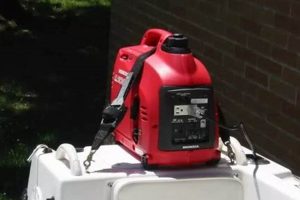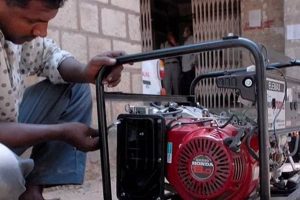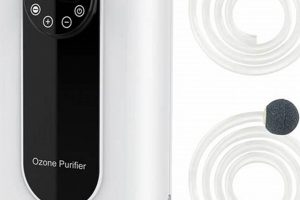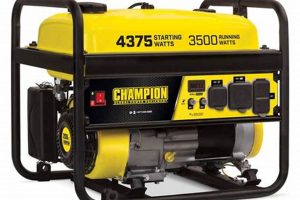Housing solutions for mobile power sources range from simple DIY projects using readily available materials to commercially manufactured, weatherproof enclosures. Examples include structures built from plywood, metal sheeting, or repurposed sheds, as well as purpose-built sound-attenuated and ventilated boxes. These solutions aim to protect generators from the elements, reduce noise pollution, and improve safety.
Safe and effective operation of mobile power sources outdoors necessitates careful consideration of environmental factors and potential hazards. A well-designed housing offers protection from rain, snow, and excessive heat, prolonging the generator’s lifespan. Furthermore, enclosures help mitigate noise, benefiting both the operator and surrounding community. Proper ventilation within the structure is crucial for safe exhaust dispersal and preventing carbon monoxide buildup. Historically, generator housings evolved from rudimentary covers to sophisticated enclosures integrating sound dampening, ventilation systems, and security features, reflecting increasing awareness of safety and environmental concerns.
The following sections will delve into specific design considerations for constructing or selecting appropriate housings for portable generators, including material selection, ventilation strategies, soundproofing techniques, and safety measures.
Tips for Effective Generator Enclosures
Properly enclosing a portable generator enhances safety and usability while minimizing environmental impact. The following tips offer guidance for successful enclosure design and implementation.
Tip 1: Prioritize Safety: Ensure adequate ventilation to prevent carbon monoxide buildup. Incorporate safeguards against electrical hazards and fire risks.
Tip 2: Size Appropriately: The enclosure should accommodate the generator with sufficient space for maintenance access and airflow. Overly tight enclosures restrict cooling and increase fire hazards.
Tip 3: Choose Durable Materials: Select weather-resistant materials such as pressure-treated lumber, metal sheeting, or purpose-built composite panels to protect the generator from the elements.
Tip 4: Implement Effective Ventilation: Include strategically placed intake and exhaust vents to facilitate proper airflow and prevent overheating. Consider using ducting to direct exhaust gases away from occupied areas.
Tip 5: Minimize Noise Pollution: Incorporate sound-dampening materials like acoustic foam or mass-loaded vinyl within the enclosure walls to reduce noise levels.
Tip 6: Secure the Enclosure: Implement measures to secure the generator against theft and unauthorized access. Locking mechanisms and anchoring systems can enhance security.
Tip 7: Consider Location: Position the enclosure away from windows, doors, and air intakes to minimize noise and exhaust fumes entering buildings.
Tip 8: Regular Maintenance: Periodically inspect the enclosure for damage and ensure ventilation systems remain clear and functional.
By following these guidelines, one can create a safe, efficient, and environmentally responsible housing solution for a portable generator, maximizing its utility while mitigating potential risks.
These considerations contribute to a comprehensive understanding of how best to house a portable generator for optimal performance and safety.
1. Safety
Safety represents a paramount concern in portable generator enclosure design. Enclosures must mitigate several inherent risks associated with generator operation, primarily carbon monoxide poisoning, fire hazards, and electrical shock. Failure to address these risks can lead to severe injury or death. For instance, inadequate ventilation can cause lethal carbon monoxide to accumulate within the enclosure and spread to occupied areas. Flammable materials used in construction, combined with the heat generated by the engine, create a significant fire risk. Improper grounding and exposed electrical components pose an electrocution hazard, especially in damp conditions. A real-world example highlighting the importance of enclosure safety involves a family who unknowingly placed their generator too close to their home’s air intake, leading to carbon monoxide poisoning.
Effective enclosure design incorporates several critical safety features. Adequate ventilation, achieved through strategically placed intake and exhaust vents, ensures proper airflow and prevents carbon monoxide buildup. Using fire-resistant materials in construction minimizes fire risks. Grounding the generator and ensuring all electrical connections are properly insulated prevents electrical shocks. Furthermore, incorporating features like automatic shutoff switches in case of overheating or fuel leaks adds an extra layer of protection. Proper placement of the enclosure, away from doors, windows, and air intakes, further reduces risks. Regular inspection and maintenance of the enclosure are crucial to ensure ongoing safety.
Prioritizing safety in portable generator enclosure design is not merely a recommendation but a necessity. Addressing potential hazards through thoughtful design and diligent maintenance safeguards users and those nearby. Neglecting these critical safety measures can have devastating consequences. Understanding the inherent risks associated with generator operation and implementing appropriate safety measures are essential for responsible and safe power generation.
2. Ventilation
Ventilation plays a crucial role in portable generator enclosure design. Combustion engines require substantial airflow for both operation and cooling. Restricting this airflow leads to overheating, reduced performance, and potential engine damage. More critically, inadequate ventilation prevents the safe dispersal of exhaust gases, particularly carbon monoxide, a colorless, odorless, and highly toxic gas. Accumulation of carbon monoxide within the enclosure poses a severe health risk, potentially leading to fatal consequences. A real-world example involves a case where improper ventilation in a generator enclosure resulted in carbon monoxide poisoning, highlighting the critical nature of this aspect of enclosure design.
Effective ventilation strategies for generator enclosures involve carefully calculated intake and exhaust vent placement. Intake vents supply fresh air for combustion and cooling, while exhaust vents expel combustion byproducts. Vent size and placement must be optimized to ensure adequate airflow while minimizing noise and weather intrusion. Ducting can direct exhaust gases away from occupied areas, further enhancing safety. Calculating the required airflow based on the generator’s power output and incorporating appropriate vent sizes ensures effective ventilation. Placement of vents should consider prevailing wind direction to optimize natural airflow and prevent exhaust re-circulation. Using louvered vents prevents rain and debris from entering the enclosure while maintaining airflow.
Proper ventilation is not merely a design recommendation but a critical safety requirement for portable generator enclosures. Understanding the principles of airflow and combustion byproducts is essential for effective enclosure design. Ignoring ventilation requirements can lead to severe consequences, ranging from engine damage to life-threatening carbon monoxide poisoning. Careful consideration of vent size, placement, and ducting ensures safe and efficient generator operation within the enclosure, mitigating potential risks and maximizing the generator’s lifespan.
3. Sound Mitigation
Operating portable generators often introduces substantial noise pollution, impacting both the operator and the surrounding environment. Sound mitigation within enclosures becomes crucial for maintaining comfortable sound levels and promoting harmonious coexistence. Addressing noise levels enhances usability and minimizes disturbances, creating a more peaceful and productive environment.
- Material Selection
Specific materials play a significant role in absorbing and deflecting sound waves. Dense, porous materials like acoustic foam, mass-loaded vinyl, and sound-dampening blankets effectively reduce noise transmission. Choosing appropriate materials for enclosure construction significantly impacts overall sound reduction. For example, lining the interior walls of an enclosure with specialized acoustic foam demonstrably lowers perceived noise levels. Conversely, using thin, rigid materials allows sound to transmit easily, amplifying the noise. Strategic material selection represents a fundamental aspect of effective sound mitigation.
- Enclosure Design
The physical structure of the enclosure itself influences sound propagation. Solid, airtight construction minimizes noise leakage. Decoupling the generator from the enclosure frame using vibration-dampening mounts reduces the transmission of vibrations, which translate into audible noise. Consider a tightly sealed enclosure constructed from thick, sound-absorbing materials. This design minimizes noise leakage and contains sound waves effectively. Alternatively, an enclosure with gaps and thin walls allows sound to escape, amplifying the noise and diminishing the effectiveness of sound mitigation efforts.
- Ventilation Strategies
While essential for safe operation, ventilation openings can inadvertently contribute to noise escape. Strategically designed baffles and mufflers within ventilation ducts mitigate noise while maintaining airflow. Imagine an enclosure with straight ventilation ducts. These ducts allow sound to travel directly outwards, amplifying noise. In contrast, incorporating baffles within the ducts disrupts the sound waves, reducing noise output without compromising airflow.
- Location and Orientation
Careful consideration of the enclosure’s placement and orientation further contributes to sound mitigation. Positioning the enclosure away from reflective surfaces and directing exhaust outlets away from populated areas minimize noise propagation. For instance, placing an enclosure near a wall might reflect sound waves, increasing perceived noise levels. Strategically positioning the enclosure away from such reflective surfaces minimizes this effect and optimizes sound mitigation strategies. Furthermore, directing the exhaust outlet towards an open space, rather than towards a neighbor’s property, demonstrates consideration and minimizes noise impact.
Integrating these facets of sound mitigation into portable generator enclosure design creates a significantly quieter operating experience. Reduced noise levels not only benefit the operator but also minimize disturbance to the surrounding environment, making generator usage more practical and considerate. Through strategic material selection, thoughtful enclosure design, careful ventilation planning, and appropriate placement, noise pollution can be substantially reduced, enhancing the overall usability and acceptance of portable generators.
4. Weather Protection
Weather protection constitutes a critical aspect of portable generator enclosure design. Exposure to the elementsrain, snow, wind, and extreme temperaturescan significantly impact a generator’s lifespan and functionality. Moisture intrusion can corrode electrical components, leading to malfunctions or complete failure. Freezing temperatures can damage engine parts and fuel lines. Excessive heat can impede proper cooling, reducing efficiency and increasing the risk of overheating. A real-world example demonstrating this importance involves a generator left unprotected during a heavy rainstorm, resulting in irreparable damage due to water infiltration into the electrical system.
Effective weather protection strategies for generator enclosures encompass several key elements. Utilizing durable, weather-resistant materials for construction forms the foundation. Options include pressure-treated lumber, metal sheeting (galvanized or stainless steel), and weatherproof composite panels. Properly sealed seams and joints prevent water ingress. Sloped roofs facilitate water runoff, preventing accumulation and potential leaks. Adequate ventilation, while crucial for operation, must be balanced with weather protection to prevent rain or snow from entering the enclosure. Louvered vents and strategically placed overhangs allow airflow while deflecting precipitation. Elevating the generator off the ground using a concrete pad or stand protects against flooding and moisture damage from below. Furthermore, incorporating features like drip edges and gutters further enhances weather protection by directing water away from the enclosure.
Robust weather protection safeguards the generator investment, ensuring reliable performance and prolonging its operational life. Addressing potential weather-related damage through thoughtful design and material selection is essential for maintaining the generator’s functionality in diverse environmental conditions. Failing to adequately protect the generator from the elements can result in costly repairs or complete replacement, highlighting the practical significance of prioritizing weather protection in portable generator enclosure design. This careful consideration of weather protection ensures the generator remains a reliable power source, regardless of external conditions.
5. Material Selection
Material selection significantly influences the effectiveness of a portable generator enclosure. Chosen materials directly impact durability, weather resistance, sound attenuation, and cost-effectiveness. A robust enclosure requires materials capable of withstanding environmental stresses while providing adequate protection and functionality. For instance, using thin plywood for an enclosure intended for outdoor use might offer initial cost savings but will likely deteriorate rapidly due to weather exposure, ultimately requiring premature replacement. Conversely, investing in more durable materials like weather-treated lumber or powder-coated steel ensures long-term protection and minimizes lifecycle costs. Selecting materials with inherent sound-dampening qualities, such as mass-loaded vinyl, contributes to noise reduction, a crucial aspect of responsible generator operation.
Material choices present a range of options, each with inherent trade-offs. Metal sheeting offers excellent durability and weather resistance but can be prone to rust if not properly treated (e.g., galvanized or stainless steel) and may require additional soundproofing measures. Plastic composites provide lightweight and weather-resistant alternatives but may lack the structural strength of metal counterparts. Wood, while cost-effective and easily workable, requires consistent maintenance (e.g., painting or staining) to resist rot and insect damage. Analyzing the specific environmental conditions and desired performance characteristics informs appropriate material selection. Considering factors like average rainfall, temperature fluctuations, and proximity to corrosive elements (e.g., saltwater) ensures the selected materials can withstand the anticipated stresses. An enclosure intended for coastal deployment necessitates highly corrosion-resistant materials, unlike one designed for a dry, inland environment. Similarly, enclosures operating in areas with heavy snowfall require robust roof structures capable of supporting significant snow loads.
Appropriate material selection is fundamental to a successful portable generator enclosure. Balancing durability, weather resistance, sound attenuation, and cost informs optimal choices. Careful consideration of environmental factors and performance requirements ensures the selected materials align with the enclosure’s intended purpose and contributes to a long-lasting, functional, and safe generator housing solution. Failing to prioritize material selection can lead to premature deterioration, compromised performance, and increased maintenance costs, ultimately undermining the enclosure’s protective function.
Frequently Asked Questions about Portable Generator Enclosures
Addressing common inquiries regarding portable generator enclosures provides clarity for safe and effective implementation. The following FAQs offer practical guidance for various aspects of enclosure design and usage.
Question 1: What is the primary purpose of a portable generator enclosure?
Enclosures serve to protect generators from the elements, mitigate noise pollution, and enhance safety during operation.
Question 2: Is ventilation necessary for a generator enclosure?
Absolutely. Ventilation is crucial for safe operation. It prevents the buildup of toxic exhaust gases, particularly carbon monoxide, and facilitates engine cooling, preventing overheating and potential damage.
Question 3: What materials are suitable for building a generator enclosure?
Suitable materials include weather-resistant options such as pressure-treated lumber, metal sheeting (galvanized steel, stainless steel, or aluminum), and weatherproof composite panels. Material selection should consider durability, weather resistance, and sound-dampening properties.
Question 4: How can noise levels be reduced in a generator enclosure?
Noise reduction can be achieved through the use of sound-dampening materials like acoustic foam, mass-loaded vinyl, or sound blankets within the enclosure walls. Strategic vent placement and the use of baffles in ventilation ducts also contribute to noise mitigation.
Question 5: Where should a generator enclosure be placed?
Optimal placement positions the enclosure away from windows, doors, and air intakes of buildings to minimize noise and prevent exhaust fumes from entering occupied spaces. Consider prevailing wind direction to direct exhaust away from populated areas.
Question 6: Does a generator enclosure require regular maintenance?
Regular inspection and maintenance are essential. Ensure ventilation systems remain clear of obstructions, check for signs of wear or damage, and address any necessary repairs promptly to maintain safe and efficient operation.
Understanding these fundamental aspects of portable generator enclosures ensures safe, efficient, and considerate operation, maximizing the benefits while mitigating potential risks.
For further detailed information and specific design considerations, consult professional resources and relevant safety guidelines.
Portable Generator Enclosure Ideas
Exploration of portable generator enclosure ideas reveals the critical importance of balancing functionality, safety, and environmental responsibility. Key considerations include adequate ventilation for safe exhaust dispersal and thermal management, robust weather protection for equipment longevity, effective sound mitigation for minimizing noise pollution, and appropriate material selection for structural integrity and performance. Discussed design elements and construction techniques demonstrate the potential for optimizing generator enclosures to meet specific operational requirements and environmental contexts.
Careful consideration of portable generator enclosure ideas enables safe and efficient power generation while mitigating potential risks and minimizing environmental impact. Implementing these principles contributes to responsible generator usage, fostering a balance between power accessibility and community well-being. Investing time and resources in proper enclosure design ultimately benefits both generator owners and the wider community.






